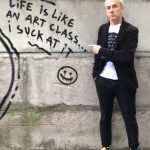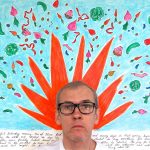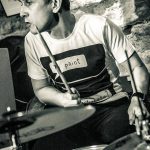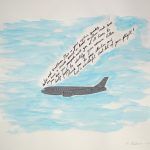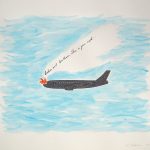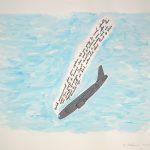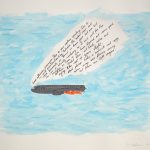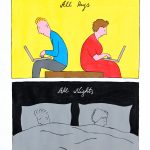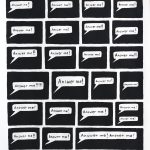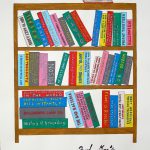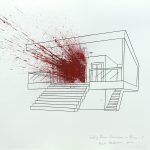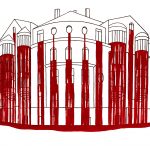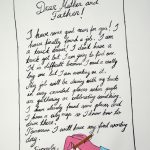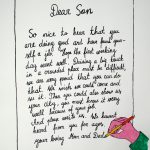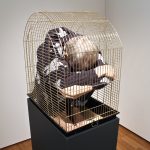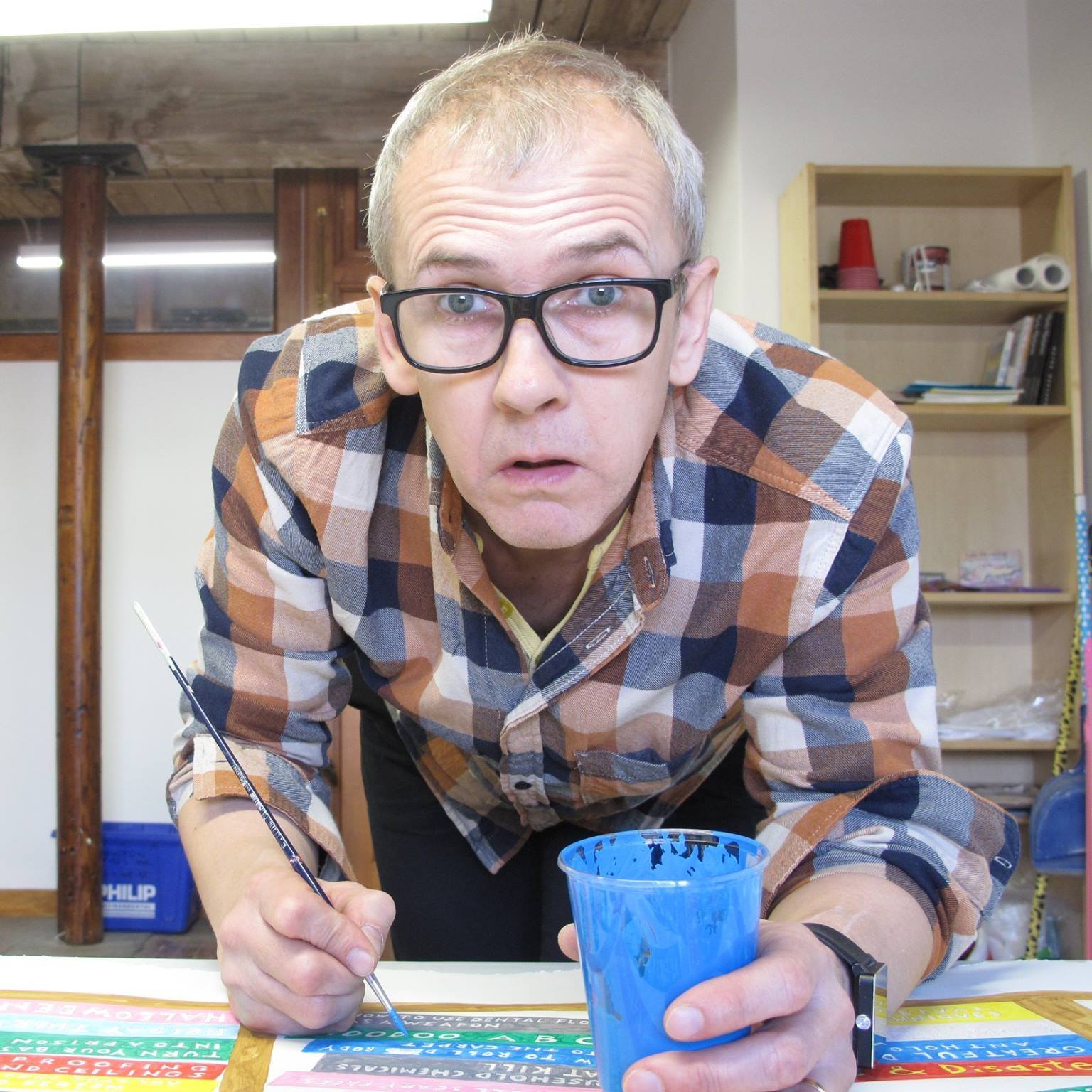
Marko Mäetamm (Estonia) joined us here at the Cotton Factory for a month-long Artist Residency this past November. Check out my full interview with him below:
Carissa: What is it like to live and make art in Tallinn? How do you feel that the exposure to historical architecture differs between Tallin and Hamilton (and any other city you would like to reference)? Do you feel that living and working in an architecturally preserved space, changes your artistic and personal experience?
Marko: There is indeed a beautiful architecturally preserved old part in our town – an extremely beautiful medieval part. It was bombed by the Russians during the Second World War, but fortunately there is much left since thankfully, during the Soviet time, they didn’t do much to destroy or alter the buildings, so it looks quite authentic today. It’s a great little town that once belonged to the famous Hanseatic League.
Yet this old town is only one part of Tallinn. It is surrounded by many other things. Just a 10-minute walk from it you can find yourself in a completely contemporary city with high buildings made of glass and concrete, plus a lot of nice old wooden architecture, art nouveau, functionalist minimalism, Stalinist buildings and buildings from the grey Soviet period – everything. All that is compressed in a small area, way smaller than Hamilton is. I live in a pretty anonymous block of flats just a 30-minute walk from the old part. I don’t feel like I live in an architecturally preserved place at all, so it doesn’t influence me like that. Tallinn is so diverse, one of the most diverse places I have ever seen. You should definitely come and see it.
For me, the only negative thing about living in Tallinn is its small size where almost everybody knows each other. The rest is all very positive. It is vibrant, creatively loaded, with a relevantly ambitious and active art community. And, if you get bored you can always take a boat and go to Helsinki for a day. It is only 80 km away.
As an artist, I don’t feel too influenced by the space around me. It can be Tallinn, New York or Miami. Or Berlin. Or Hamilton, Ontario. I can work everywhere as long as I have some decent working conditions. But, what definitely does influence me is what is going on inside me, and this is directly connected with the environment around me. I want to be connected with my time, I want to read the news, meet people and feel things. This is where my ideas come from.
Carissa: “For me, the only negative thing about living in Tallinn is its small size where almost everybody knows each other.” If you don’t mind expanding on this? You mentioned that you live in a pretty anonymous block of flats. Is anonymity important to you? If you don’t feel that you get that in Tallin, how do you work with it?
Marko: Yes we live on a sixth floor in a big block of flats so nobody really looks through our window and I don’t know our neighbours names. In comparison to the small town in South Estonia where I grew up, Tallinn is a really big city. But still – after living here for more than 20 years it’s not such a big place. Which has, of course, both good and bad side. The good side is that it is pretty easy to organize things. People are accessible, and whoever you need to get in touch with, there is always somebody amongst your friends who knows this person or at least knows somebody who knows this person. Everybody is two, maximum three phone calls away from you.
The same thing can be very annoying sometimes, so talking about the bad side of it I should say exactly the same thing that I just said. Working in a field of art and being active on the scene for more than at least 10 years means that literally, everybody in Estonia knows you. It’s not like you are a star or something but everybody simply knows you because you have been on TV, radio, in the newspaper and have exhibited in every possible venue there. Every artist has studied in the same art university and is later involved in teaching at the same place. It’s not so much about being a big fan of anonymity, but it’s still great not to be surrounded by the same people day after day. For me travelling to some other country, being an artist in residence, working in a new place – very healthy.
Carissa: Do you listen to music? If so, what kind of music do you lean towards? Do you have periods of silence in your life? If so, when and why. Are there any patterns in this noise/stimulation vs silence for you?
Marko: I do. I always listen to something when I work in the studio. In Tallinn, I most often listen to one specific Estonian radio channel which has talk shows, news and music all throughout the day. I like different stuff – J.J. Cale, Ray Charles, Joni Mitchell, Jeff Lynn, Five Young Cannibals, Blondy, The Police, Tom Petty, AC/DC, ZZ Top, The Beatles, Rolling Stones, Eric Clapton, Mike Oldfield, Thin Lizzy, Depeche Mode, The Darkness, Led Zeppelin…just to drop some names that first come to my head. My children educate me about more recent music and I love a lot of new stuff too, but I am bad with all these names. My absolute favourite is Neil Young. I like his attitude and his honesty. Brilliant, brilliant artist.
Regarding silence, I go through periods of silence – probably not periods but moments. Sometimes you need to be alone with your thoughts and listen/sense what is going on inside you. I like jogging or just walking long distances sometimes and these are the moments of silence for me when I can connect to what is going on inside. Or when I meditate.
I don’t know why it is so, but having some music on or the radio playing in the background helps me to switch off from all the other thoughts in my head. It kind of isolates me from the world around me, creates some kind of a bubble and helps to keep a focus on what I do. The only time I need silence is when I write something or work with words or text in my art.
Carissa: You went to an Art Academy to study printmaking – a structured organization – and yet today, you seem to dislike “rules”. Did you have any experiences whilst studying printmaking that challenged or developed your beliefs about art and rules in this area? Have you always believed rules to be a hindrance to the process of creativity, or has this belief system developed over time? Do you see any place for rules or structure in the process of art?
Marko: Surprising question. I never thought of myself as a person who dislikes rules. I think we all need rules in our life. Just like we need our body to get things done in this world. Or, like we need four walls around us to be protected from cold and to understand what is inside and what is outside. Without rules, it would be an unimaginable mess. But, what I believe and what I think artists should definitely do is challenge the rules, bend them, extend the space and find some new territories. Use the rules creatively and stay in a critical position instead of simply following them.
Any organization needs to be structured and schools are definitely very structured organizations. I studied printmaking simply because I didn’t know anything about painting or sculpture and thought printmaking is probably the closest thing to drawing which I knew a little bit about. It appeared to be quite technical of course but it did suit me well, and we had a lot of freedom to do what we really wanted to do. I don’t think my years of being an art student or studying printmaking taught me to be critical of rules. It was rather like being on holiday for me after two years in the Soviet Army with all the most stupid rules one can ever imagine.
Talking about making art there are also tons of rules you need to keep in mind, stay critical about and try to break. If there were no rules – how on earth can you achieve your artistic freedom?
Carissa: I was taking that cue from your video interview where you discuss rules, but perhaps what you were getting at is the point of trying to break away from rules through the carving of one’s own path? In the jazz world, there is an understanding and a teaching that we learn the rules in order to forget them. I like what you said, “if there were no rules – how on earth can you achieve your artistic freedom?”. In this way, artistic freedom is something that is achieved through the process of creating art following some foundational understanding of the rules/history of the art form. Personally, after studying music, I found it so challenging to forget the rules and always felt that I was looking for that childlike innocence I once had before I learned them. I suppose it’s very similar to life in general and maybe art is a reflection of the human struggle…how we are always trying to get back to a certain childlike innocence, a true being present in the now. What are your thoughts on this?
Marko: I think so too – art as part of a bigger picture (life) is a tiny model of what it is part of. It functions the same way. I totally believe that doing art I am solving some bigger problems in front of me or inside of me. Childlike innocence… subconsciously or intuitively moving towards it – to me personally, it does make sense, yes.
Carissa: In your video interview, you mention that you feel art for the sake of decoration serves no function – why is this? If the experience of creativity and the making of art is individual and unique to all of us, how do you qualify what is made simply for decoration and what has meaning or function behind it?
Marko: You are absolutely right – the experience of creativity and the making of art is individual and everybody has their own right to decide why and with what purpose they make art. What I said in this interview was also my individual statement, not anything general. What I mean by simply decorative art is something that is really just beautiful and well crafted but doesn’t try to tell me much and doesn’t have much presence of the author…something that is nice and beautiful but totally risk-free. Try to imagine two rooms – in both rooms, there is a hunting gun hanging on the wall above the sofa. In one room it is a real and very simple hunting gun and it is probably even loaded. In the other room, is a fancy old Winchester with golden decorations but it is a model, not the real one that can shoot. For me, the room with the real gun on the wall is definitely more intriguing and more thought than the room with a fancy model gun. But many people may think totally the opposite of course and I don’t have any problem with that.
Carissa: You mention being more interested in the process of creating and less about the final result. How do you balance this desire to simply create with the need to create something that supports your livelihood or to produce work for a show? Do you have any thoughts regarding the idea of living as an artist and whether or not it is wise or otherwise, to depend on one’s art and passions to provide financial stability?
Marko: Yes, I think being inside the process of creating/making is definitely something that I need to feel more in balance with. But, as much as I need to be in the process of making I also need communication with the audience to feel that I am doing the right thing. So, showing my art is definitely part of the process and a very important part. I am not doing art because of fun or just killing time, I am doing it because I want to create a dialogue with other people and talk about things I am concerned about, or I find important to talk about. Art is like a communication channel for me.
I don’t know if it is good or bad but it is very hard for me to separate these categories – this work I do for supporting my livelihood, this work I do for the show in my studio practice. It is usually quite a struggle for me to do commissioned work, but as a freelance artist, I have to do it of course. It is like stepping out from your comfort zone and pushing your borders, the same thing that I was talking before. These processes are very useful and teach me a lot about myself although I am not enjoying them. Strangely enough, it is very useful to be pushed in the corner sometimes.
Carissa: There is a truth in the artistic and creative community that once you create something and release it to the world it is no longer yours. After all, we cannot control the “other’s” response to our work. Do you agree with this truth and if so, do you have any philosophies or practices to avoid becoming attached to the outcome of a piece or a project? What are your thoughts on this?
Marko: This is all very familiar to me. When I was younger I was always so troubled by seeing the audience interpret my work differently from the way I saw it. That made me push harder each time to make myself clear and articulate better, the message I thought my work should carry. Next time exactly the same thing happened and I was even more desperate. It took me years to grow out of this and make peace with the fact that you can not really control this situation. Today when I work, I still do my best to articulate what I want to say with my work but I am totally okay if people interpret my work differently. I may not be overly happy about it but it doesn’t disturb me. The only thing that would really disturb me is if there are no reactions.
Carissa: I find it very hard to believe that anyone could look at your art and have no reaction, and almost feel that if someone showed no response to your work, that the choosing to not respond is a response in and of itself. There is a layer of activism to your work, through the very nature of how ‘in your face’ your work appears. It is incredibly direct and forces the audience into a state of either total awareness or (I can only imagine) complete shutdown due to an unwillingness to face the subject matter, or an awkwardness that results from not being sure how to react. When I walked into your studio at the Cotton Factory in November, I myself was shocked by the direct nature of your work and it fascinated me. It’s like you put on paper in obvious ways, some of the things that people think but don’t dare to express out of fear of offending someone, or their own family for that matter. Some people might say that you are very brave, but I get the feeling that to you, these conversations are a natural part of your experience of life – that you want to interact with the world and to stimulate conversation about news headlines and to challenge the assumptions that we carry from day to day. To you, there is nothing brave about it, and as you said, you are not doing this for fun or to kill time, but to start a dialogue about things that concern you.
Marko: I also feel there is nothing to do with being or not being brave. It is something else. I just want to share my thoughts and communicate with other people. I am quite shy by nature but through doing art (as well as playing the drums) I don’t have any problems with it.
Carissa: As you explain in the video, shallowness and power games are a part of every aspect of life and unfortunately, the art world is no exception. How have you managed to avoid falling into the trap of participating in power games and “the right way to be”? Have you always been conscious of this struggle in your pursuit of creativity? What advice might you have for artists in maintaining a creative practice that is light and free from the harsh realities such as this?
Marko: I am not sure if I can give any good advice. Probably just to be honest with yourself and follow your own ethics. There are so many ways to live your life and build up your career. I think what really matters is how you feel at the end of the day, which ultimately means at the end of your life. Have you stepped over other people, played some nasty games, cheated, lied to yourself by doing what is fashionable at the moment and what you think other people want you to do etc. or followed your own heart? I have always tried to do the latter but it is of course not always so simple. Things are never as simple as they sound.
Carissa: So true – things really aren’t ever black and white. I used to be utterly convinced that I needed to pursue music full time and to base my entire income around it, but with each year that passes and as I grow in my ability to view the world critically, my view towards art and the role that it plays in society also changes. Especially when there are artists like you who are challenging us to view things differently, or simply to not ignore our realities, it helps to remind me that art can function in a very expansive way. With the pressure to make a living from one’s art, one easily loses the freedom to create art that stimulates conversation. Of course, it is never simple, but underneath all of this is the question of whether or not the individual feels fulfilled by the work that they create, and everyone will have different needs and wants in this area based on their experience and history. For example, you were in the Soviet Army and the very fact that you had the privilege of studying art in school felt like a holiday in comparison, as you mentioned earlier. Perhaps some of us take the very existence of art and the practice of it for granted as we have not experienced the same things that you or the people of Estonia have. Do you feel that this informs your approach to creating art with such impact?
Marko: Of course – we are all what we eat as well as what we live through. And what we create is directly connected to what we are (if it comes from our heart) Being born in 1965 in Soviet Estonia or being born in 1965 somewhere in the free world, Canada for instance, were definitely two totally different stories.
Carissa: Can you describe what your time here in Hamilton (Toronto/Ottawa) and at the Cotton Factory was like? Did you venture into the city much or engage with other artists? What is your take on what is happening here?
Marko: I really enjoyed this month in Hamilton. I found the Cotton Factory to be a really great place to work. It was also a very good balance between being productive in my studio and meeting other people. One month is actually a very short time and I didn’t really venture into the city much, but I had some nice artist talks in Hamilton, Toronto and even in Ottawa, so I had some time to look around. I made some really good friends. I definitely want to come back.
Carissa: We certainly hope to have you back! When people see your work, what are you hoping the takeaway is? Do you have any best-case scenario wishes regarding what your art conveys to your audience?
Marko: I cannot control how people see my work and what they think of it, or what they think of me as an artist. I am happy if my work causes reactions and triggers people to think of certain things in their life or in the world around them. I am also happy if people still remember my work the next day after seeing a show. Or, to go back to what I said before, good art is like a loaded hunting gun on the wall – well made, eye-catching, provocative and a bit dangerous. That is the kind of art I want to offer to my audience.
Carissa: And that you do! Thank you so much for sharing some of your world with us, Marko. You certainly have created a memorable impression on me and many others here at the Cotton Factory and in the Hamilton area.
Continue below for images of Marko and his work! Click on the image to zoom in and read the text.
- Photo of Marko
- Photo of Marko in front of his work here at the Cotton Factory
- Photo of Marko playing the drums
- Airplane Announcement-1
- Airplane Announcement-2
- Airplane Announcement-3
- Airplane Announcement-4
- Airplane Announcement-5
- Always Together, acrylic on paper, 100x70cm, 2016
- Answer Me!, acrylic on paper, 100x70cm, 2016
- Bad Man’s Bookshelf
- Bleeding House Somewhere In Miami-5, ink on paper, 56x75cm,2014
- Bleeding House-10, oil on canvas, 150x200cm, 2017
- Dear Mother and Father!, acrylic on paper, 100x70cm, 2017
- Dear Son, acrylic on paper, 100x70cm, 2017
- Self Portrait In A Cage, life size figure in a cage, mixed media, 2015

